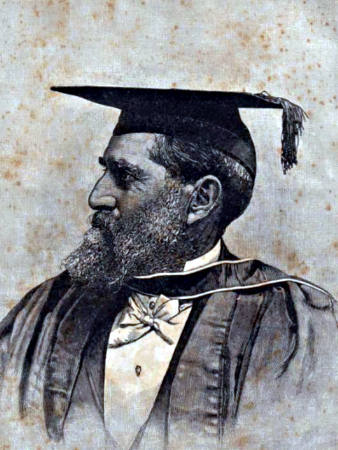Society of Science, Letters and Art, London
Joseph Ostler,the first district secretary of the newly established Moorabbin Roads Board, absconded in 1867, after approximately five years work, with funds sufficient to match his annual salary fourteen times over. [1] After adventures on the goldfields in United States of America and a bigamous marriage in New Orleans he wrote a book and published it in San Francisco in 1874. The book was titled, “Howard’s California Calculator, The Newest, Quickest and Most Complete Instructor for All Who Desire to be Quick at Figures.” There were at least three other books concerned with arithmetical calculation and all noted the authorship of C Frusher Howard. Frusher was the maiden name of Ostler’s mother.
In one of the books there is a portrait of C Frusher Howard in academic gown and mortar with the notation Fellow of the Society of Science, Letters and Art, London. At first sight this membership in a ‘grand’ society seems a little pretentious for a man whose occupations had previously been listed as ‘grocer’ and ‘butcher’, and whose formal education may have been limited. Nevertheless, there can be no doubt that his books required some scholarship. They were financially very successful, being published in both America and Britain, and with the profits he was able to return the money he stole to the Shire of Moorabbin.

Joseph Ostler alias C Frucher Howard F.S Sc., in mortar, gown and hood. Courtesy Kingston Collection.
What was this Society of which he was a member? Two letters published in London’s, Times give some insight.
H Trueman Wood, the Secretary of the Society of Arts, was concerned about the confusion that was being created in the minds of people between the Society of Science, Letters and Art in London with his own society. Writing in the Times, February 23, 1883, he noted the SSLA appeared to be migratory in character, for its various circulars list a variety of addresses; Tollington Park, Sydenham, Shepherd’s Bush and Kensington. He acknowledged his ignorance of its operations even though “it seemed closely connected with his own business.” But he had discovered that the by-laws of the organization made provision for its members to wear “gowns and hoods”, as well as “gold and silver decorations” and there was no objection to members “employing after their names any quantity of letters they might consider attractive or ornamental.”
Trueman Wood became aware of the Society of Science, Letters and Art when its secretary invited newly elected members of his own society to subscribe to the SSLA. Some did so believing the offer was authorised by, or was part, of the Society of Arts. When informed of the true situation they applied for a refund but this was not granted although in one or two cases there was a promise of restitution.
Trueman Wood believed a society that undertook such action could not be widely known but saw it as a pity it could be confused with another society. He made a “slight request” that it change its name to the Society of Letters, “a name less confounded with that of the Society of Arts”. Trueman Wood went on to hope “that this enterprise may be induced to shine without the aid of borrowed light and may eventually obtain the full measure of its real deserts”. He noted the address of his society as being at Adelphi.
The following week H V Goold, Baronet., chairman of the Society of Science, Letters and Art of London responded to Trueman Wood’s suggestions in his letter to the Times. [2] He agreed with Trueman Wood on the substance of some of his statements but was critical of the words used. It was correct that his society could adopt its own insignia (not decorations) and members could use a small number (not quantity) of letters F.S.Sc. after their names. This group of letters he believed could not be confused with any other society.
Referring to “borrowed light”, Goold wrote that his society was not conscious of any “aid” from the Society of Arts and would certainly prefer to “shine” by the “light of its own little stars than by reflection from the great gas lights and electric sparks of the Adelphi.” “Surely,” he continued, “no member of the Society of Arts is so devoid of intelligence as not to be able to distinguish between the names, addresses, objects and operations of the two societies!”
Goold rejected Trueman Wood’s suggestion that the Society of Science, Letters and Art should reduce its title to Society of Letters, as this would create confusion with the existing society of Society of Literature as well as forcing it to work in a “narrow groove”. His society had existed for several years, and he claimed, was supported by a large and influential body of gentlemen, including many members of the Society of Arts. Goold wondered whether being a member of one society prohibited you from joining another which their secretary may needlessly deem a rival.
Joseph Ostler, alias C Frusher Howard F.S.Sc., returned to Brighton in the late 1890s where his membership of the Society of Science, Letters and Art was not noted. Nevertheless, by his membership a tenuous link is provided in the history of the Shire of Moorabbin with a London ‘learned society’ of the nineteenth century.
Footnotes
- See Joseph Ostler District Official absconds with Funds in 1867 – Article 206 http://localhistory.kingson.vic.gov.au
- Times, London, March 6, 1883 page 4
